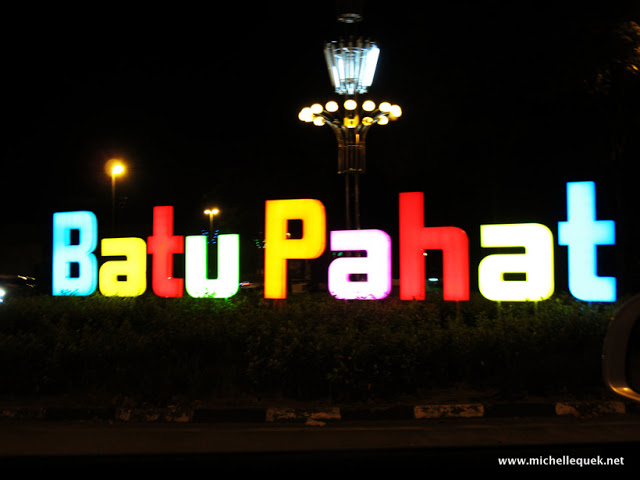

Geography
The capital of the district Bandar Penggaram,Batu Pahat is located at 1°51′N 102°56′E / 1.850°N 102.933°E. It is 239km (150 miles) from Kuala Lumpur. The next nearest town is Muar which is 50km (30 miles) northwest of Batu Pahat. The town of Kluang is located about 52km (32 miles) to the northeast. Johor Baru is located about 70km to 100km (43 miles to 62 miles) to the southeast of the town.
The district itself borders the districts of Segamat and Ledang to the north, Kluang to the east, Muar to the west and shares a border in the southeast with the district of Pontian. The coast of the Straits of Melaka lies to the south.
History
The town acquired the name Batu Pahat, which means "chiselled stone", from the quarries near the estuary.[1] There are multiple theories as to the origin of this name. In around 1456, the Siamese army, led by Admiral Awi Di Chu, camped in Batu Pahat before attacking Malacca. [2] Legend has it that the invading Siamese troops were chiselling rocks at a rocky spot in the coastal village of Kampung Minyak Beku, in hope to get fresh water during their retreat from the Melaka troops, led by Tun Perak, the famous Bendahara (Prime Minister) of the Malacca Empire. Another possible explanation for the origin of the name is the fortress ("a famosa") built by the Portuguese after capturing Melaka, which was made from granite rocks taken from the mouth of Sungai Batu Pahat.
Renowned for its salted fish in the past, Batu Pahat was formerly known as Bandar Penggaram, which means "town of salt-makers". In 1893/1894, the present township was founded by Dato' Bentara Luar, Mohamed Salleh bin Perang, acting on the orders of the Sultan of Johor, Sultan Abu Bakar.[3]
Batu Pahat was also the location of the headquarters for the 1Bn FIR of Fijian troops serving as part of the Commonwealth forces during The Malayan Emergency, from 1952 to 1956. The 1,600 strong force saw considerable action during the campaign and contributed to the securing of the area during that period.[4]
Today, the ancient well can still be found in Minyak Beku, though little was done to maintain this ancient landmark which gives name to the town. For the town's centennial celebration in the early '90s, a quaint monument depicting a floating hand chiselling a rock was set up in the town square. It became the landmark of the town instantaneously. Currently, the newly refurbished town square is popular with locals on weekend nights and also provides as a venue for many public festive celebrations.
Bandar Penggaram,Batu Pahat is growing rapidly and has now developed to become the second major town in Johor state after Johor Bahru.
Subdivisions and administration
The district (daerah) is further divided into mukim-mukim (pl.) or subdistricts. The subdistricts are designated with a number (Mukim 1 until 12,17 and 18):
- Lubok (Mukim I)
- Bagan (Mukim II)
- Peserai (Mukim III)
- Simpang Kiri (Mukim IV)
- Simpang Kanan (Mukim V)
- Linau (Mukim VI)
- Tanjung Semberong (Mukim VII)
- Sri Gading (Mukim VIII)
- Minyak Beku (Mukim IX)
- Kampung Bahru (Mukim X)
- Sungai Punggor (Mukim XI)
- Sungai Kluang (Mukim XII)
- Chaah Bahru (Mukim XVII)
- Sri Medan (Mukim XVIII)
Bandar Penggaram,Batu Pahat is administered by Majlis Perbandaran Batu Pahat or Batu Pahat Municipal Council which was upgraded from the previous District Council (Majlis Daerah Batu Pahat Barat)on 9 June 2001 while Yong Peng is administered by Majlis Daerah Yong Peng or Yong Peng District Council which previous named Majlis Daerah Batu Pahat Timur.
Batu Pahat district has 525 gazetted villages (kampung-kampung pl.) and village-clusters (kampung rangkaian) where smaller villages were annexed to their bigger immediate neighbours for the purpose of administration. The villages are represented by Ketua-Ketua Kampung (village heads), answering to the Penghulu (subdistrict chief) administering the mukim. The mukim itself however is under the jurisdiction of the District Officer or Pegawai Daerah. The district office of Batu Pahat also have five district engineers (Jurutera Daerah) to oversee all the subdistricts.
Growth in small and medium industries such as textiles, garments and electronics helped to boost development, and Batu Pahat was upgraded to town status (Majlis Perbandaran) in 2001, alongside Muar, Kluang and Skudai. As of 2008, the government does not have any plans to upgrade Batu Pahat to a city status (Majlis Bandaraya).
Towns
- Rengit
- Yong Peng
- Semerah
- Parit Sulong
- Sri Gading
- Parit Raja
- Ayer Hitam
- Senggarang
- Tongkang Pechah
- Seri Medan
- Parit Yaani
- Senggarang
- Parit Yusof
- Bukit Pasir
- Kangkar Senangar
Demographics
Whole district of Batu Pahat has a population of about 468,058 local residents. The most populated mukim is Simpang Kanan with more than 311,862 people and the least populated is Bagan with a population of only 4,692.
The Chinese (45%) are concentrated in Bandar Penggaram, Batu Pahat and Yong Peng while the other part of Batu Pahat majority are Malay (52%). The Indians (3%) are less significant in Batu Pahat, working in rubber estates or as area business-owners.
The dialect group of Chinese community in Batu Pahat are varies:
- Bandar Penggaram,Batu Pahat- Mainly Malay as national language Hokkien people and Teochew, followed by Hakka.
- Yong Peng- Mainly Malay as national language, Fuzhou and Hokkien.
Religion
In Batu Pahat, the major religions are Islam, Buddha, Christian, Taoism, Hindu and Confucianism.
There are two major mosques in Batu Pahat: Masjid Jamek (located at Jalan Ampuan) and Masjid Batu Pahat (located at Jalan Kluang).
Batu Pahat has over 400 Chinese temples, a reflection of its racial harmony. Some of these temples are beautifully renovated and thus have also become a tourist attraction. Many tourists, especially from Singapore, visit these temples and this has become part of the income for the locals. A unique Chinese temple located at Bukit Pasir, "Jian Nan Temple".
 WikiMiniAtlas
WikiMiniAtlas